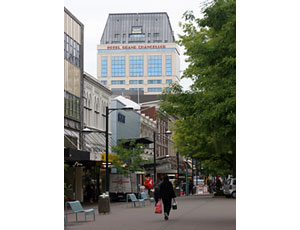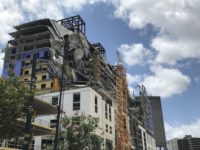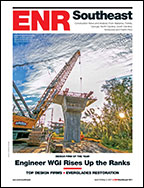Four days after the magnitude-6.3 Canterbury quake that shook Christchurch, destroying significant areas of the city, rescue operations in the central business district are almost complete except for the zone around the 26-story Hotel Grand Chancellor, which is leaning and near collapse.

The city has cordoned off the area around the hotel, say Christchurch city officials.
Built in 1986 and operated by Grand Hotels International, the concrete-framed building is 85 m tall, according to the Council on Tall Buildings and Urban Habitat.
If the structure doesn’t collapse it will have to be demolished.
Meanwhile, the death toll as of Feb. 25 in New Zealand’s second-largest city has risen to at least 113, with 228 still missing.
The deadliest building failure occurred at the Canterbury Television (CTV) building, where more than 125 people are thought to have been trapped inside, including 90 students from Kings Education language school.
Other significantly damaged buildings are the 110-year-old Christ Church Cathedral, where some 20 people likely died; the PGC building, where there are 14 people trapped and the Trocadero Bakery, where three people died.
Just over 80% of power has been restored to Christchurch, as of 9:30 pm, local time, Feb. 25, according to canterburyearthquake.org.nz, a website managed by the City Council and CDEM Group. Weeks will be needed to restore full power because of damage to the network, says Orion, the power utility in central Canterbury, the South Island region that includes Christchurch.
The condition of the roads remains a worry. As of 9 p.m. local time on Feb. 24, 18 bridges and 25 distributor roads remained impassable due to flooding and structural or surface damage, says the government. Eastern parts of the city are the most affected.
While some bridges have sustained minor damage all are safe, and all other state highways in the region are open. The N.Z. Transport Agency (NZTA) expects to reopen the Lyttelton tunnel to all traffic by Saturday afternoon (it has been open to emergency vehicles only.) The structure of the severely damaged tunnel canopy was removed, and the agency has been allowing fuel tankers through the tunnel under escort.
A rail link between Lyttelton and Christchurch remains closed due to bridge damage near Heathcote.
House inspections continue in the suburbs, where 186 were designated uninhabitable in Christchurch and nearby Lyttelton, which is close to the quake’s 5-km-deep epicenter.
The eastern suburbs have significantly more liquefaction, and will require tens of thousand more tonnes of sand removed, between 100,000 and 150,000, than was needed after the magnitude-7.1 quake that hit last Sept. 4, when only 30,000 tonnes was removed.
Two American Society of Civil Engineers’ members, David Biggs and Roberto Leon, were in Christchurch when the earthquake struck. Biggs was just finishing up a presentation as part of a seminar on seismic assessment and improvement of buildings and foundations when the quake struck and both he and Leon are working as volunteers to conduct structural inspections.




Post a comment to this article
Report Abusive Comment